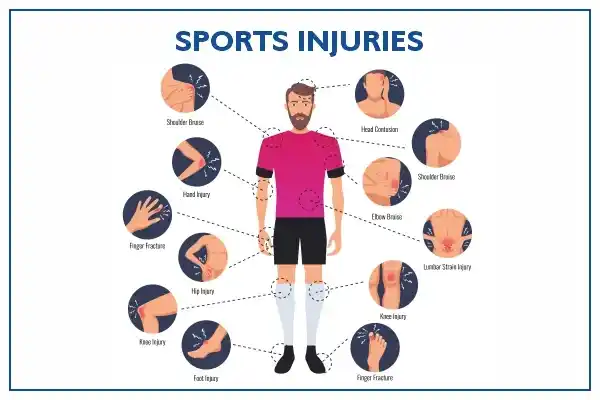Categories
- Cardiology 84
- Dermatology 45
- Endocrinology 33
- ENT 16
- Fertility 190
- Gastroenterology 78
- General-Medicine 81
- Gynecology 80
- Hematology 19
- Infectious-Diseases 33
- Neurology 52
- Oncology 34
- Ophthalmology 23
- Orthopedics 69
- Pediatrics 31
- Procedure 23
- Public-Health 144
- Pulmonology 59
- Radiology 8
- Urology 68
- Wellness 161
- Woman-and-child 77

What Are Sports Injuries?
“Sports injuries” are injuries that happen when playing sports or exercising. Some are from accidents. Others can result from poor training practices or improper gear. Some people get injured when they are not in proper condition. Not warming up or stretching enough before you play or exercise can also lead to injuries.
- Sprains and strains
- Knee injuries
- Swollen muscles
- Achilles tendon injuries
- Pain along the shin bone
- Fractures
- Dislocations

Secure your health with a second opinion. Make informed decisions and book your appointment today!
Get A Second OpinionWhat are the Difference Between an Acute and a Chronic Injury?
Acute:
- Sudden, severe pain
- Swelling
- Not being able to place weight on a leg, knee, ankle, or foot
- An arm, elbow, wrist, hand, or finger that is very tender
- Not being able to move a joint as normal
- Extreme leg or arm weakness
- A bone or joint that is visibly out of place
Chronic:
Chronic injuries happen after you play a sport or exercise for a long time. Signs of a chronic injury include:
- Pain when you play
- Pain when you exercise
- A dull ache when you rest
- Swelling
What Should I Do if I Get Injured?
Never try to “work through” the pain of a sports injury. Stop playing or exercising when you feel pain. Playing or exercising more only causes more harm. Some injuries should be seen by a doctor right away. Others you can treat yourself.
Call a doctor when:
- The injury causes severe pain, swelling, or numbness
- You can’t put any weight on the area
- An old injury hurts or aches
- An old injury swells
- The joint doesn’t feel normal or feels unstable
If you don’t have any of these signs, it may be safe to treat the injury at home. If the pain or other symptoms get worse, you should call your doctor. Use the RICE (Rest, Ice, Compression, and Elevation) method to relieve pain, reduce swelling, and speed healing. Follow these four steps right after the injury occurs and do so for at least 48 hours:
Rest:
Reduce your regular activities. If you’ve injured your foot, ankle, or knee, take weight off of it. A crutch can help. If your right foot or ankle is injured, use the crutch on the left side. If your left foot or ankle is injured, use the crutch on the right side.
Ice:
Put an ice pack to the injured area for 20 minutes, four to eight times a day. You can use a cold pack or ice bag. You can also use a plastic bag filled with crushed ice and wrapped in a towel. Take the ice off after 20 minutes to avoid cold injury. Compression : Put even pressure (compression) on the injured area to help reduce swelling. You can use an elastic wrap, special boot, air cast, or splint. Ask your doctor which one is best for your injury.
Elevation:
Put the injured area on a pillow, at a level above your heart, to help reduce swelling.
How Are Sports Injuries Treated?
Treatment often begins with the RICE method. Here are some other things your doctor may do to treat your sports injury.
Nonsteroidal Anti-Inflammatory Drugs (NSAIDs) :
Your doctor may suggest that you take a nonsteroidal anti-inflammatory drug (NSAID) such as aspirin or ibuprofen. These drugs reduce swelling and pain. You can buy them at a drug store. Another common drug is acetaminophen. It may relieve pain, but it will not reduce swelling.
Immobilization
Immobilization is a common treatment for sports injuries. It keeps the injured area from moving and prevents more damage. Slings, splints, casts, and leg immobilizers are used to immobilize sports injuries.
Surgery:
In some cases, surgery is needed to fix sports injuries. Surgery can fix torn tendons and ligaments or put broken bones back in place. Most sports injuries don’t need surgery.
Rehabilitation (Exercise)
Rehabilitation is a key part of treatment. It involves exercises that step by step get the injured area back to normal. Moving the injured area helps it to heal. The sooner this is done, the better. Exercises start by gently moving the injured body part through a range of motions. The next step is to stretch. After a while, weights may be used to strengthen the injured area.
As injury heals, scar tissue forms. After a while, the scar tissue shrinks. This shrinking brings the injured tissues back together. When this happens, the injured area becomes tight or stiff. This is when you are at greatest risk of injuring the area again. You should stretch the muscles every day. You should always stretch as a warmup before you play or exercise.
Don’t play your sport until you are sure you can stretch the injured area without pain, swelling, or stiffness. When you start playing again, start slowly. Build up step by step to full speed.
Rest
Although it is good to start moving the injured area as soon as possible, you must also take time to rest after an injury. All injuries need time to heal; proper rest helps the process. Your doctor can guide you on the proper balance between rest and rehabilitation.
Other Therapies
Other therapies include mild electrical currents (electrostimulation), cold packs (cryotherapy), heat packs (thermotherapy), sound waves (ultrasound), and massage.
What Can People Do to Prevent Sports Injuries?
These tips can help you avoid sports injuries.
- Don’t bend your knees more than half way when doing knee bends.
- Don’t twist your knees when you stretch. Keep your feet as flat as you can.
- When jumping, land with your knees bent.
- Do warm up exercises before you play any sport.
- Always stretch before you play or exercise.
- Don’t overdo it.
- Cool down after hard sports or workouts.
- Wear shoes that fit properly, are stable, and absorb shock.
- Use the softest exercise surface you can find; don’t run on asphalt or concrete.
- Run on flat surfaces.
For adults:
- Don’t be a “weekend warrior.” Don’t try to do a week’s worth of activity in a day or two.
- Learn to do your sport right. Use proper form to reduce your risk of “overuse” injuries.
- Use safety gear.
- Know your body’s limits.
- Build up your exercise level gradually.
- Strive for a total body workout of cardiovascular, strength-training, and flexibility exercises.
For parents and coaches:
- Group children by their skill level and body size, not by their age, especially for contact sports.
- Match the child to the sport. Don’t push the child too hard to play a sport that she or he may not like or be able to do.
- Try to find sports programs that have certified athletic trainers.
- See that all children get a physical exam before playing.
- Don’t play a child who is injured.
- Get the child to a doctor, if needed.
- Provide a safe environment for sports.
For children:
- Be in proper condition to play the sport.
- Get a physical exam before you start playing sports.
- Follow the rules of the game.
- Wear gear that protects, fits well, and is right for the sport.
- Know how to use athletic gear.
- Don’t play when you are very tired or in pain.
- Always warm up before you play.
- Always cool down after you play.
Ready to take control of your health journey? Book your appointment now and start your path towards wellness today!
Book an AppointmentWhat Research Is Being Done on Treating Sports Injuries?
Today, treating a sports injury is much better than in the past. Most people who get sports injuries play sports and exercise again. Doctors have many new ways to treat sports injuries. Some of these new ways include:
- Arthroscopy (fiber optic scopes put through small cuts in the skin to see inside joints)
- Tissue engineering (using a person’s own tissues or cells to help heal injuries)
- Targeted pain relief (pain-reducing drug patches put directly on the injured area).
- Advanced imaging techniques (like x rays) that will lead to better diagnosis and treatment.
Frequently Asked Questions
Stress fractures: bone pain caused by small cracks that develop in a bone as a result of repeated stresses (for example, during high-impact activities like cross country running) leg cramps: shin pain caused by inflammation of the tissues surrounding the shin is common in sports that involve running.
The seven most common sports injuries are:Ankle sprain,Groin pull,Tendon twist,Splints on the shin,Knee injury: ACL tear,Knee injury:Tennis elbow (epicondylitis).
Sports injuries are injuries that occur while playing sports or exercising. Sports injuries can occur due to overtraining, poor conditioning, and improper form or technique.
Sports injuries can be classified in relation to the type of tissues injured, eg. Eg soft tissues (muscle, skin) or hard tissues (bone). Most often, sports injuries are classified in relation to their cause. The main types are primary, secondary, direct, indirect, and chronic lesions.
The difference between a sprain and a strain is that a sprain injures the bands of tissue that connect two bones, while a strain involves an injury to a muscle or to the band of tissue that connects a muscle to a bone.
Common examples of chronic injuries include tennis elbow. Swimmer's shoulder. Runner's knee and jumper's knee.

Categories
- Cardiology 84
- Dermatology 45
- Endocrinology 33
- ENT 16
- Fertility 190
- Gastroenterology 78
- General-Medicine 81
- General 6
- Gynecology 80
- Hematology 19
- Infectious-Diseases 33
- Neurology 52
- Oncology 34
- Ophthalmology 23
- Orthopedics 69
- Pediatrics 31
- Procedure 23
- Public-Health 144
- Pulmonology 59
- Radiology 8
- Urology 68
- Wellness 161
- Woman-and-child 77